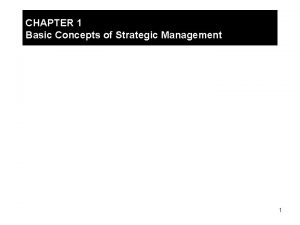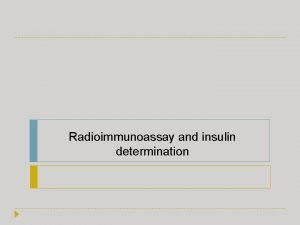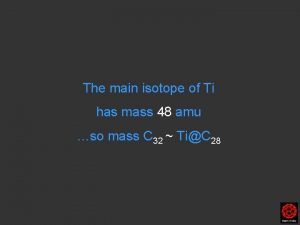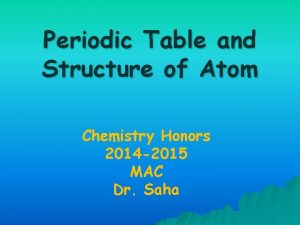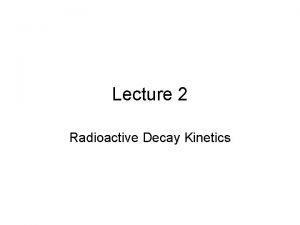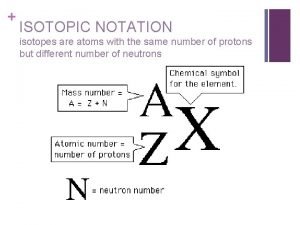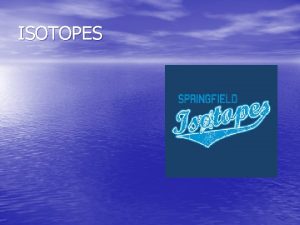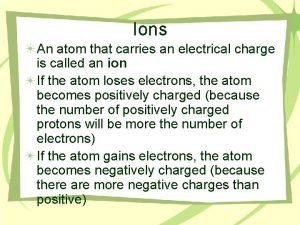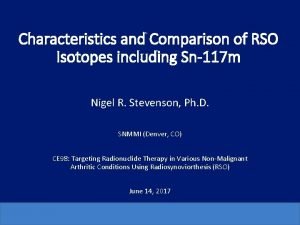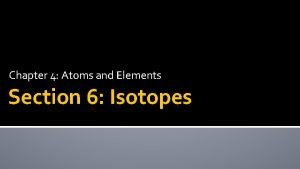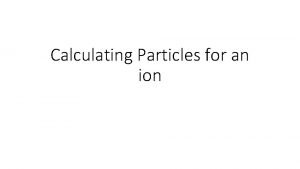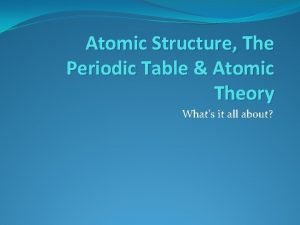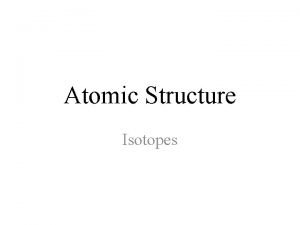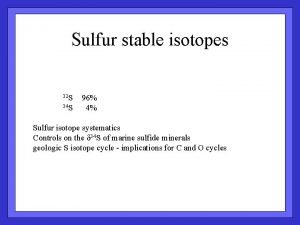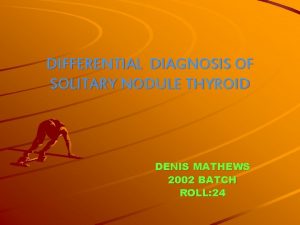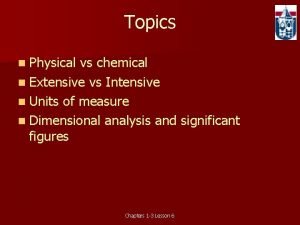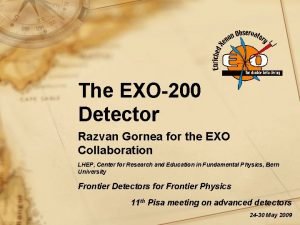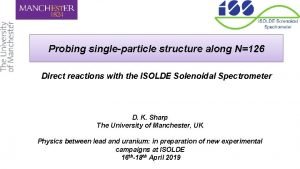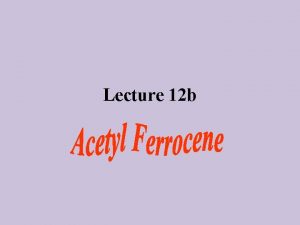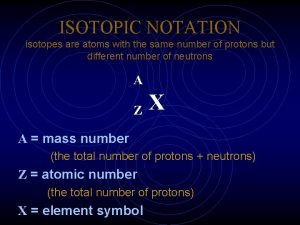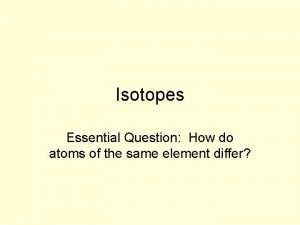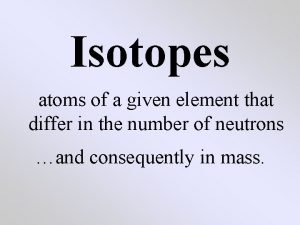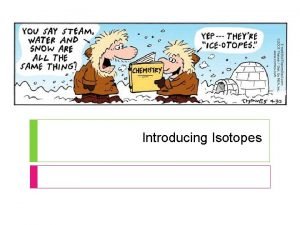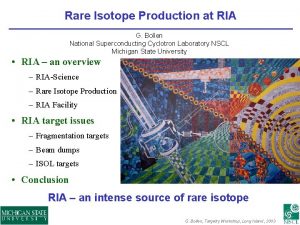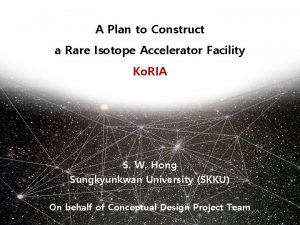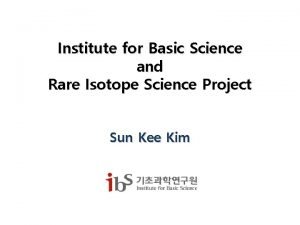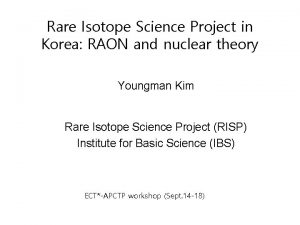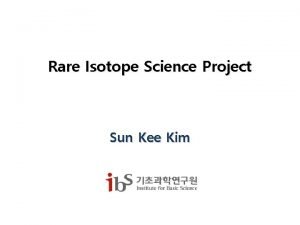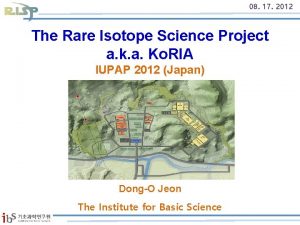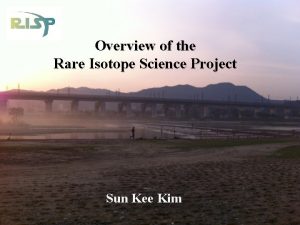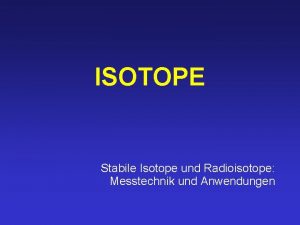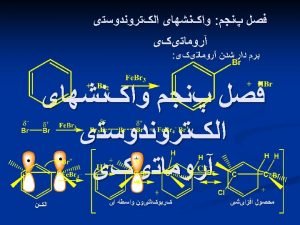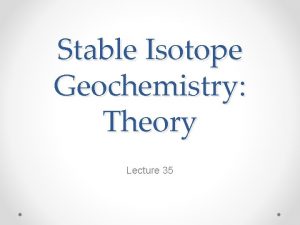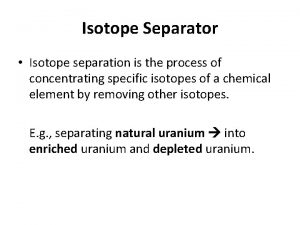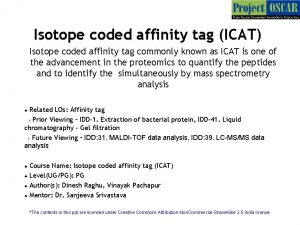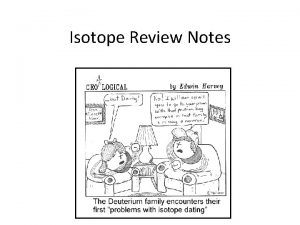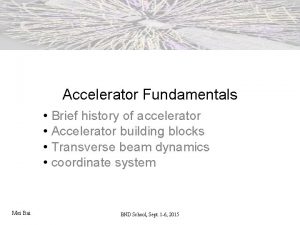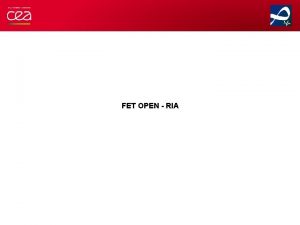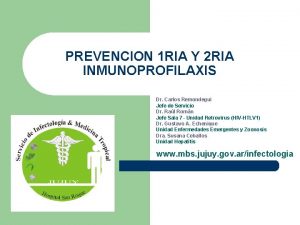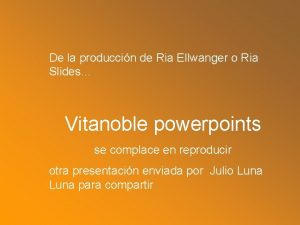Science of Rare Isotope Accelerator RIA and the




























- Slides: 28

Science of Rare Isotope Accelerator (RIA) and the Project Status Witold Nazarewicz (UT/ORNL) • Introduction • RIA Science • RIA Facility • RIA Project Status • Summary

The Nobel Prize in Physics 2004 Gross, Politzer, Wilczek. Many-Body The Nuclear relativistic heavy ions electron scattering Problem radioactive beams few body heavy nuclei quarks gluons vacuum quark-gluon soup QCD nucleon QCD few body systems many body systems free NN force effective NN force

Nuclear Landscape 126 superheavy nuclei stable nuclei 82 protons known nuclei s s e oc 50 8 20 2 8 28 ine l rip d on r t neutrons o r p r terra incognita 82 pr p 20 2 pr 50 28 r n o t o ip r d e lin s s ce neutron stars

subfemto… • How does complexity emerge from simple constituents? • How can complex systems display astonishing simplicities? nano… many m u t Quan s hysic p y d bo • Origin of NN interaction • Many-nucleon forces • Effective fields Giga… femto… Physics of Nuclei • In-medium interactions • Symmetry breaking • Collective dynamics • Phases and phase transitions • Chaos and order • Dynamical symmetries • Structural evolution How do nuclei shape the physical universe? Nucl Astro ear physi cs • Origin of the elements • Energy generation in stars • Stellar evolution • Cataclysmic stellar events • Neutron-rich nucleonic matter • Electroweak processes • Nuclear matter equation of state

We need access to neutron- or proton-rich nuclei Ab Initio The ultimate goal of the physics of nuclei is to develop a unified, predictive theory of nucleonic matter Density Functional Theory asymptotic freedom… • What is the mechanism of nuclear binding? • How do fission and fusion work? • What are the phases and symmetries of nucleonic matter?

Change of Shell Structure in Neutron Rich Nuclei Near the drip lines nuclear structure may be dramatically different. First experimental indications demonstrate significant changes No shell closure for N=8 and 20 for drip-line nuclei; new shells at 14, 16, 32

What are the limits of atoms and nuclei? Three frontiers, relating to the determination of the proton and neutron drip lines far beyond present knowledge, and to the synthesis of the heaviest elements lifetimes > 1 y Do very long-lived superheavy nuclei exist? What are their physical and chemical properties?

Out-law nuclei of the nuclear borderland

Based on National Academy of Science Report [Committee for the Physics of the Universe (CPU)] Question 3 How were the elements from iron to uranium made ?

How does the physics of nuclei impact the physical universe? • What is the origin of elements heavier than iron? • How do stars burn and explode? • What is the nucleonic structure of neutron stars? Nuclear Input (experiment and theory) X-ray burst 4 U 1728 -34 Frequency (Hz) 331 Masses and drip lines Nuclear reaction rates Weak decay rates Electron capture rates Neutrino interactions Equation of State Fission processes 330 329 328 s 15 20 Time (s) r rp pr Nova s se s ce ing rn n-Star o r p t us bu st ell ar T Pyxidis protons ss e c Supernova pro oc 10 ss e oc r p s- es 327 p ss e oc r p RIA intensities (nuc/s) 2 > 1012 Mass 10 known 1010 Half-life 10 -2 known 10 -6 known 106 nothing Cr KS 1731 -260 neutrons E 0102 -72. 3

r (apid neutron capture) process Supernovae ? The origin of about half of elements > Fe (including Gold, Platinum, Silver, Uranium) Neutron star mergers ? Open questions: • Where does the r process occur ? • New observations of single r-process events in metal poor stars • Can the r-process tell us about physics under extreme conditions ? Swesty, Calder, Wang

The r-process neutron capture timescale: ~ 0. 2 ms Rapid neutron capture b-decay Proton number Seed (g, n) photodisintegration Neutron number Equilibrium favors “waiting point”

Accreting neutron stars Neutron star (H and He burn into heavier elements) Accretion disk (H and He fall onto neutron star) Companion star (H + He envelope)

X-ray bursts 15 s Lines during bursts EXO 0748 -676 (1735 -444) Cottam, Paerels, Mendez 2002 ms burst oscillations Off-state Lum. 4 U 1728 -34 KS 1731 -260 Frequency (Hz) 331 330 Deciphering observations of Hubble, CHANDRA … NASA/Chandra/Wijnands et al. Superbursts 329 328 (4 U 1735 -44) 10 15 Time (s) Strohmayer Bhattacharyya et al. 2004 6 h 18 time (days) 327 18. 5 20

Tests of the Standard Model Parity violation studies in francium 82 protons Weak interaction studies in N=Z nuclei EDM search in radium 50 Specific nuclei offer new opportunities 82 for precision tests of: 28 20 50 8 2 20 2 8 126 28 neutrons § § § CP and P violation Unitarity of the CKM matrix … How will we turn experimental signals into precise information on physics beyond the standard model?

Applications: Science for the Betterment of Mankind “One of the frontiers of our science is to manipulate nuclei to create new elements and isotopes both for science and, eventually, for societal needs. Often, the applications rely on our ability to select specific nuclei with particular decay modes, halflives, and energies. Perhaps most importantly, the field provides a superb venue for the important mission to educate and train the next generation of nuclear scientists, who will play key roles not only in basic research itself, but in myriad applied fields”. From : White Paper on the Intellectual Challenges of RIA, prepared for Dr. R. Orbach LENP generates over 40% of Ph. Ds in nuclear science • Human Health • Environment, Geosciences, Oceanography, . . • Nuclear Energy • Food & Agriculture • Material Sciences • Chemistry and Biology • History, Art, Archeology • National Security: Ø Ø Ø Stewardship of the Nations Nuclear Weapons Stockpile Homeland Security/Non-Proliferation Diagnostics for High Energy Density Physics Facilities

Milestones in RIA Development NSAC has endorsed RIA six times • • 1996: Advanced ISOL facility and MSU upgrade are given the highest priority for new construction within the field of nuclear physics in the United States in the DOE/NSF 1996 Long Range Plan. “We strongly recommend development of a plan for a next generation ISOL-type facility and its construction when RHIC construction is substantially complete”. 1999: ISOL Task Force concludes “building a world-leading accelerator facility is a scientific imperative for the United States. ” Task Force sets performance standards, recommends technical approach to facility and estimates cost. Task Force recommends commissioning Conceptual Design Report in the immediate future. 2001: NSAC Subcommittee reviews RIA preliminary cost estimate: “reasonable” and “appropriate”. April 2002 DOE/NSF Long Range Plan: “RIA is the highest priority for major new construction for nuclear physics in the United States. ” March 2003 NSAC Facilities Subcommittee: “absolutely central to nuclear physics” and “ready to initiate construction” 2003 DOE RIA R&D Workshop -- 112 participants- DOE RIA R&D Panel – “credible reference designs exist” and “most of the potential risks … have now been removed” January 04 NSAC Comparison of RIA and GSI: “very strong science case”, “upgrade of GSI will not duplicate the capability of RIA”.

Office of Science Facilities Plan (November 2003)

The Rare Isotope Accelerator • $1000 M • $180 M peak • Operating cost comparable to JLAB • Best facility in the world to study nuclei and pursue nuclear astrophysics (See Bond NSAC Subcommittee report) • Costs in line with other rare isotope facilities under construction or consideration • Must be unique and world leading in 2015, and serve the community for 20+ years.

Each of the Four Beam Energy Ranges is Required for Important Physics NUCLEAR STRUCTURE Framework of singleparticle states and closed shells Interplay of deformation and single particle effects ASTROPHYSICAL RATES FUNDAMENTAL INTERACTIONS NUCLEAR STRUCTURE Direct measurements of reactions in hot stars, rp-process and breakout of hot CNO cycle Fundamental symmetries. PV, EDM, Beta-decay studies of physics beyond the standard model Decay studies at the limits of stability Limits of stability at drip lines Matrix elements connecting to ground state. E&M and breakup Physics at the proton drip line Masses - r-process, rpprocess, symmetries Heavy elements Nuclear moments by hyperfine interactions Halos and skins Beta decay studies of rare nuclei Indirect measurements of astrophysical processes APPLICATIONS Nuclear equation of state Indirect measurements of astrophysical processes APPLICATIONS Fission barriers

Combination of Capabilities Unique to RIA þ Optimized production technique for each isotope þ Factors of 10 -100 higher beam intensities for inflight isotopes best facility to study the rprocess path & structure at the n-drip line þ Experiments with reaccelerated beams wide variety of nuclear structure and reaction techniques, direct measurement of reaction rates for astrophysics, production of new elements, . . þ ISOL production with 10 X higher yields or more stopped (atomic parity violation, isotope harvesting & stockpile stewardship, . . ) & reaccelerated beams þ Combination of in-flight separation & gas cell fast development path for stopped & reaccelerated beams of all elements þ Facility optimized for and dedicated to experiments with rare isotopes

The value of RIA…

RIA User Community • Based on data collected for Long Range Plan, user community in the RIA areas of physics is comparable to those of RHIC and JLab. • Currently >800 members of RIA Users Group. • Expect 500 -750 RIA users to participate in experiments each year. • OECD Megascience forum estimates ~2000 users of rare isotope facilities worldwide.

What happened since November’ 03? A Roller Coaster Ride (see http: //www. orau. org/ria/ for details) November 2003 February 2004 March 2004 June 2004 August 2004 September 2004 October 2004 February 2005 April 2005 DOE’s Office of Science 20 -Year Science Facility Plan CD-0 Mission Need approved RIA Science endorsed by the interagency panel NSAC RIA-GSI Report RIA Theory Group Charter approved DOE issues pre-solicitation form for RIA construction Third RIA Summer School (ORNL, MSU, ANL, LBNL) RIA Informational website established by DOE RIAUO Charter Ratified (>800 scientists, 35 countries) Draft Request for Proposals (RFP) posted by DOE Administration FY 2006 budget released (bad news for science) Energy Secretary: “Very important program both for nuclear physics and national security” May 11, 2005 May 16, 2005 ? ? ? RIA Day in D. C. House markup recommendation: additional $6 M to initiate the conceptual design process RFP issued by DOE CD-1, CD-2…

Summary • The study of nuclei remains a forefront area of science. – Huge discovery potential – Merit – Relevant to many other fields and applications • RIA is required advance the science in the next decade. RIA: Connecting Nuclei with the Universe

BACKUP SLIDES

Comparison of RIA to other RI Facilities • NSCL CCF is lower in yield by a factor of 100 for the lightest elements and more than 10, 000 for heavier elements. No post acceleration capability. • ISAC/TRIUMF is limited to traditional ISOL production of ions. This means intense beams of a limited number of nuclides. • RIKEN RIF will have 400 Me. V/u uranium, but with 100 x less intensity and no post acceleration capability. • GSI will have 1. 5 Ge. V/u uranium but with 10 -100 x less intensity and no post acceleration capability. It is also a multi-faceted facility with limited beam time. • Europe and Japan are discussing an advanced ISOL facility to complement GSI and RIKEN. ISOL limitations RIA has the performance to reach the scientific goals for which it was conceived

 What is your favourite subject
What is your favourite subject Basic concept of strategic management
Basic concept of strategic management Rare consequential and directive
Rare consequential and directive Insulin ria
Insulin ria Ti-48 isotope
Ti-48 isotope What is this called
What is this called Radioactive decay equation
Radioactive decay equation Isotopic notation example
Isotopic notation example Whats an isotope
Whats an isotope An atom that carries a charge is called
An atom that carries a charge is called Sn-117 isotope
Sn-117 isotope Isotope symbol
Isotope symbol Percent abundance formula
Percent abundance formula Iron isotope notation
Iron isotope notation How to calculate abundance in isotopes
How to calculate abundance in isotopes Isotope symbol
Isotope symbol Ký hiệu proton
Ký hiệu proton 32s isotope
32s isotope Solitary nodule thyroid
Solitary nodule thyroid Function of thyroxin
Function of thyroxin 26mg isotope
26mg isotope 136ba isotope
136ba isotope Hg-200 isotope
Hg-200 isotope Ferrocene
Ferrocene Isotope notation practice
Isotope notation practice Whats an isotope
Whats an isotope Isotopes labeled
Isotopes labeled The isotope atoms differ in *
The isotope atoms differ in * What does the number represent in the isotope platinum-194
What does the number represent in the isotope platinum-194

